

8 Reasons Guitars Goes out of Tune (And How to Fix It)
Are you wondering why you guitar keeps going out of tune, and what you can do about it? Here are the top 8 reasons why a guitar goes out of tune!
Why do guitars go out of tune?
- The strings are old
- The strings are low quality
- Bending the strings
- The intonation isn’t correct
- String slippage
- The nut is cut incorrectly
- Temperature and humidity changes
- Incorrect capo placement
How to Keep a Guitar in Tune:
To keep a guitar in tune, replace the strings frequently, make sure the guitar is intonated properly and use locking tuners.
- Replace the strings after every 100 hours of playing
- Use high quality strings
- Don’t overuse the tremolo if possible
- Make sure the guitar is intonated
- Use locking tuners
- Lubricate the guitar’s nut
- Keep the guitar in a low-humidity environment
- If using a capo, place it just behind the fret bar
What Keeps a Guitar in Tune?
Before we jump into the reasons why a guitar goes out of tune, it’s best to get clear about what mechanisms are designed to keep your guitar in tune.
The tension on the strings affects the note of the string. The tension has to be just right to make sure the string is in tune. Here are the most important parts of a guitar which affect it.
- Machine heads (tuners): turning these winds the string more, or winds it less. This either increases of decreases the string tension.
- The Nut: this is the part of the guitar where the headstock and neck meet. It has a slot for each string to sit in.
- The bridge/ saddle: this acts as the end point of the strings on the guitar’s body.
Now you know what keeps a guitar in tune, here’s what makes it go out of tune.
1. The Strings are Old
One of the biggest reasons why a guitar goes out of tune quickly, is because the strings are old. As strings get old and worn, they become less tense. You already know that the tension of the string is the ultimate factor which decides if the string is in tune or not. Old strings tend to sound sharper, because it’s harder to hold them down on the fret.
How to fix it
This one is super easy to fix. Just get some new strings! You should change your strings after every 100 hours of playing, or every 3 months, whichever comes first. Also remember to clean your strings to stop them corroding and becoming worn faster. Check out this guitar string 101 , to learn how they affect the sound and feel of your guitar.
2. The Strings are Low Quality
Another reason why your guitar might keep going out of tune, is because you’ve got low quality strings on it. The lower the string quality, the quicker they become worn and lose their tension. This is related to the first reason and can again make them sound sharp.
Make sure you don’t skimp on the string quality when you re-string your guitar. It might seem like a waste of money if you have to keep replacing them, but it’s an investment. The better the strings are, the less often they need changing and the better they’ll sound.
3. Bending the Strings
It probably won’t come as a huge suprise, but bending the strings will cause them to go out of tune faster. This happens when you bend the string manually, but the effect is a lot more significant when you use a tremolo arm. If you have a double locking tremolo bridge like the Floyd-Rose, then you’ll have less of an issue. But if you use a classic single-locking Fender-style bridge, then using the tremolo arm can pull the strings way out of tune if you’re particularly heavy handed.
how to fix it
Bending the strings less, both manually and by using a tremolo arm, will prevent the strings going out of tune as fast. But if this is key to your playing, but you don’t want the lack of tuning stability that comes with it, then consider getting a tremolo effects pedal like the Boss TR2 .
4. The Intonation Isn't Correct
If the intonation on your guitar isn’t correct, then your guitar will always sound a bit out of tune, no matter how much you try and tweak it. Here’s how to check your intonation:
- Play a note on the 12th fret
- Play the 12th fret harmonic of the same note
- Compare the pitch of the two sounds.
- If they’re the same, you’re all good!
- If not, your guitar needs some adjustments.
There are several adjustments that can be made to put the intonation right including: truss rod adjustment, bridge height adjustment, and changing the strings. If you’re not experienced in making adjustments to your guitar, then take it to a guitar store and they’ll be able to look at it and make the alterations.
5. String Slippage
If you look at your guitar’s headstock, you’ll see that the strings are wrapped around individual pegs. If the strings start slipping off the peg, then this is known as string slippage. It causes the guitar string to lose it’s tension causing to sound flat (out of tune).
Investing in locking tuners is a great way to avoid string slippage. They clamp the string around the peg to stop it slipping off. If you want to invest in some locking tuners then check out the following models:
- Fender Locking Tuners: for 6 in-line headstock configurations
- Hipshot Grip Locking Tuners: fit most electric guitars
- Schaller Locking Tuners: for 3×3 headstock configurations
6. The Nut Is Cut Incorrectly
You’ll remember that the nut is located at the joining between the guitar’s headstock and neck. It holds all the strings in position and has a slot for each individual string. The slots need to be the correct size, otherwise it causes tension, which makes it go out of tune.
You can use lubrication or file the grooves to change the size of the slots for the strings. Sometimes, you may need a new nut if it’s worn. The best thing to do, is take your guitar to a luthier to check if the nut is cut correctly, and make any adjustments if necessary.
7. Temperature and Humidity Changes
Temperature and humidity changes are a guitar’s worth nightmare. They cause a number of physical changes in the guitar which can cause many issues, from fret-buzz to tuning instability. When it’s too warm, the strings will expand, when it’s cold, they’ll contract. This affects the string tension, and consequently, whether it sounds in tune or not.
Make sure you don’t subject your guitar to extreme temperatures. You want to keep your guitar at constant room temperature and avoid storing it outside for example in your garage or car.
8. Incorrect Capo Placement
Finally, another thing that can cause your guitar to sound out of tune, is incorrect capo placement. Capos clamp the strings down, hence causing them to bend, which can pull them out of tune and make them sound sharp.
Proper capo placement is really important to make sure using one, doesn’t cause your strings to go out of tune. You should place the capo just behind the fret bar to avoid pulling the strings sharp.
More Frequently Asked Question
Why won’t my guitar stay in tune after restringing.
Don’t worry if your guitar strings go out of tune quickly after having it re-strung. This can happen for a couple of weeks after changing the strings. It’s because the new strings are stretching out faster and losing tension quickly.
You can accelerate this stretching out process by tucking your finger around each string at the 20th fret, then pushing your thumb down on it for a few seconds. Repeat this on the 12th and 5th frets. Try this 5 times to stretch the strings faster.
How long should a guitar stay in tune for?
The length of time it takes for the guitar to go out of tune depends on many things including your playing style, the string age and quality, temperature, humidity, and your bridge and nut.
New strings, go out of tune faster at the start, then once they’re stretched out, they’ll have better tuning stability. However, when they’re more worn, they go out of tune faster again.
how do you check a guitar is in tune?
If you have a good ear, then you can check if your guitar is out of tune by checking it and listening carefully. But if you don’t know how to do this, then there are three main methods you can use.
- Guitar tuning apps
- Clip-on tuner e.g Snark Super Snark 2 Clip-On Tuner
- Tuner pedals e.g Boss TU-3 Chromatic Pedal Tuner
is it bad to tune a guitar a lot?
Tuning the guitar often, and changing the tune setup, isn’t bad for a guitar. It can cause the strings to lose some tension each time you change the tune, which can cause them to wear faster, but not by a lot.
why does my guitar always sound out of tune?
This is most likely due to incorrect intonation. Here’s how to check it:
If the intonation is off, then take your guitar to a luthier to check it over and make the adjustments.
So there you go! That’s why guitars go out of tune! I hope you’ve found this article helpful, thanks for reading. Here are some other posts you might find useful:
- 5 Reasons Some Guitars Sound Better than Others
- Pros and Cons of Locking Tuners
- 6 Ways to Make a Cheap Electric Guitar Sound Great
- 7 Tips to Make your Amp Sound Better
Hey, I'm Heather. I started playing an electric guitar when I was given a Squier Strat for my birthday around 15 years ago. I now own an acoustic guitar and several electric guitars including my personal favourite, a PRS SE Custom 24.
Leave a Reply Cancel reply
Your email address will not be published. Required fields are marked *
Save my name and email in this browser for the next time I comment.
Recent Posts
Squier Sonic vs Affinity Stratocaster and Telecaster Models
Squier have recently released a new series of electric guitars, the Sonic series. The Squier Sonic series replaces the previous Bullet series and offers the most affordable entry-level guitars. The...
Fret Size Guide (Jumbo, Narrow Tall, Vintage etc.)
One of the most confusing specifications on electric, acoustic and bass guitars is the fret size. What does it actually mean? And why does it matter? In this article I'll explain everything you need...

10 Essential Tips for the Traveling Guitarist

Do you feel the call of the open road, guitar in hand? Are you ready to explore the world, sharing your music with every soul you meet? As a traveling guitarist, you’re about to embark on a journey that marries two passions – travel and music.
But as any seasoned traveler will tell you, preparation is the key to smooth sailing. This guide will discuss ten essential tips to help make your journey a memorable experience.
Introduction
There is an undeniable romance in being a traveling guitarist. Picture the lone artist, strumming their guitar under the starry sky, the crackling fire their only audience. But the life of a traveling musician isn’t always starlight and serenades.
It requires careful planning and foresight to keep your guitar safe and your music sharp. This guide will provide you with 10 essential tips for the traveling guitarist, helping you prepare for the journey ahead.
Choosing the Right Travel Guitar
The right guitar can make or break your traveling experience. When selecting a travel guitar, consider factors like size, durability, and portability. Compact and hardy models, such as the ‘Little Martin’ or ‘Baby Taylor,’ are popular choices for their travel-friendly features.

Keeping your Guitar Safe during Transit
Ensuring the safety of your instrument during transit is paramount. Invest in a good quality hard case with ample padding. Don’t shy away from adding ‘Fragile’ stickers or informing the airline staff about the instrument. Your guitar is not just another piece of luggage; it’s your musical soulmate.
Regular Maintenance and Care
Just like a car needs regular servicing, your guitar requires routine maintenance. Keep a cleaning kit with you and establish a routine for cleaning and maintaining your guitar. Remember, a well-kept guitar is a well-sounding guitar.
Insurance for your Instrument
Unforeseen circumstances can strike at any time. Having insurance for your instrument can be a lifeline if your guitar gets lost, stolen, or damaged during your travels.
Staying in Tune
Changes in temperature and humidity can throw your guitar out of tune. Always keep a portable tuner handy to ensure you’re always in tune, no matter where you are.
Portable Amplifiers and Accessories
If you’re planning to perform on the road, portable amplifiers and accessories like a capo, spare strings, and picks can be invaluable. These tools will help you deliver a stellar performance, no matter where you are.
Adjusting to Different Acoustics
Every location you play at will have different acoustics. Practice playing in various environments to adapt quickly and make the most of the acoustics available to you.
Keeping your Skills Sharp
Traveling should not mean neglecting your skills. Dedicate some time each day to practice and learn new techniques. You can also learn from local musicians you meet during your travels.
Navigating Music Laws and Regulations
Different places have different rules regarding public performances. Familiarize yourself with local music laws and regulations to avoid running into trouble.
Taking Care of your Health
Finally, don’t forget about your health. Regular rest, a balanced diet, and adequate hydration are crucial. Remember, you can’t perform at your best if you’re not feeling your best.
Delving Deeper: Understanding the Tips
Choosing the Right Travel Guitar: An Investment in Your Musical Journey
Selecting the right guitar for your travels is akin to finding the right companion for a long journey. You want a guitar that is robust, portable, and, most importantly, sounds great.
When it comes to size, smaller is usually better for travelling. A full-size dreadnought might sound amazing in your living room, but it can be a real hassle to lug around airports and train stations. Travel-specific guitars, like the ‘Little Martin,’ ‘Baby Taylor,’ or the ‘Traveler Guitar Ultra-Light,’ are designed with the traveller in mind, offering compact size without compromising on sound.
But what about durability? Well, that’s where materials and build quality come into play. Look for guitars with solid tops and high-quality hardware. Consider the climate and conditions you’ll be traveling in. Some guitars, like the ‘Composite Acoustics Cargo,’ are made from carbon fiber and are extremely durable and resistant to changes in temperature and humidity.
Lastly, you’ll want to consider portability. Some travel guitars come apart for easier transportation, like the ‘Journey Instruments OF660,’ which features a collapsible neck design.

Keeping your Guitar Safe during Transit: A Stitch in Time Saves Nine
You’ve found the perfect travel guitar, but now you need to get it from point A to point B. That’s where a good quality guitar case comes in.
A sturdy, well-padded case can be the difference between your guitar arriving safe and sound or in pieces. Hard cases offer the most protection, but they can be heavy and bulky. If you’re planning on doing a lot of walking or hiking, a padded gig bag might be a better choice. Look for cases or bags with extra pockets for storing accessories and adjustable straps for comfortable carrying.
Don’t forget to label your case with your contact information in case it gets lost. And if you’re flying, always try to take your guitar as carry-on luggage. If that’s not possible, inform the airline staff that you’re checking a fragile musical instrument. It doesn’t guarantee special treatment, but it can’t hurt.
Regular Maintenance and Care: A Labor of Love
The care and maintenance of your guitar while on the road can seem like a daunting task, but it doesn’t have to be. A little bit of regular care can go a long way in keeping your instrument in top condition.
Firstly, keep your guitar clean. Dust and grime can build up quickly, especially when you’re traveling, and can affect the sound and playability of your instrument. A simple cleaning kit with a cloth and some guitar polish can help keep your guitar looking and sounding great.
Your strings will also need some TLC. Strings get worn out over time and can break when you least expect it. Keep a set of spare strings with you and learn how to change them.
Also, pay attention to the humidity levels. Guitars are made of wood, which can warp in high humidity or crack in dry conditions. Consider investing in a guitar humidifier to keep the wood in optimal condition.
Insurance for your Instrument: Peace of Mind
While we hope nothing bad happens to our beloved instruments, the truth is accidents and misfortunes do happen. Your guitar could get damaged during transit, stolen from your hotel room, or could even get caught in a freak weather incident.
That’s where insurance comes in. Having your guitar insured gives you peace of mind, knowing that you’re covered if the worst happens. Many companies offer musical instrument insurance policies that cover loss, theft, and damage.
Before getting insurance, make sure to have your guitar appraised or keep the purchase receipt as proof of value. Also, read the policy carefully to understand what it covers and any exclusions it may have.

Staying in Tune: A Symphony of Sounds
Keeping your guitar in tune while traveling can be a challenge. Changes in temperature and humidity can cause the wood to expand or contract, throwing your guitar out of tune.
That’s why having a tuner is essential. There are plenty of compact, easy-to-use tuners available that can help you stay in tune on the go. Clip-on tuners are a popular choice because they’re small, accurate, and can be used in noisy environments.
Remember, a well-tuned guitar not only sounds better, it’s also more enjoyable to play.
Portable Amplifiers and Accessories: A Traveling Musician’s Arsenal
As a traveling guitarist, you’ll likely find yourself performing in a variety of settings. You might be playing in a bustling city square one day and a quiet beach the next. In such scenarios, having the right accessories can make a big difference.
A portable amplifier can help you project your music in louder or larger settings. Many portable amps run on batteries and are compact enough to fit in your backpack.
Other useful accessories include a capo, which can change the key of the guitar without having to adjust your hand shapes, and a slide for playing blues or country-style licks.
Don’t forget the basics – always have a bunch of spare strings and picks with you.
Adjusting to Different Acoustics: The Sound of Music
Each place you perform at will have its unique acoustic character. A cathedral will have a different sound than a small cafe, and a bustling street corner will sound different than a quiet park.
Adjusting to these different acoustics is part of the journey of being a traveling guitarist. It can be challenging, but it can also be exciting. Every new place gives you a chance to explore different aspects of your sound and performance.
To help adapt quickly, practice playing in different environments before you start your journey. Play in your bathroom, your garage, outdoors, in big rooms, small rooms, and so on.
Keeping your Skills Sharp: A Never-ending Journey
Traveling can be a whirlwind of new experiences and adventures. But amidst all the excitement, it’s essential not to neglect your guitar playing skills.
Set aside some time each day for practice. It could be in the morning before you start your day or at night before you sleep. Practice not just your old songs, but learn new ones too.
Use your travels as a source of inspiration. Write songs about the places you visit and the people you meet.
And remember, music is a universal language. Don’t be afraid to jam with local musicians or learn from them. You’ll be surprised at how much you can learn from these exchanges.
Navigating Music Laws and Regulations: Play it Safe
Music laws and regulations can vary from place to place. In some cities, you might need a permit to perform on the streets. In others, there may be restrictions on the times you can perform or the volume levels you can reach.
Before you start performing, do some research about the local music laws and regulations. You can do this online or by asking local musicians or authorities.
Respecting these laws and regulations is not just about avoiding fines or trouble. It’s also about respecting the local culture and community.
Taking Care of your Health: The Most Essential Tip
Last but certainly not least, take care of your health. Traveling can be physically demanding, and performing adds another layer of strain on your body.
Ensure you’re eating balanced meals and staying hydrated. Get enough sleep. Your body needs time to rest and recuperate, especially after a performance.
Look after your mental health too. Being on the road can be lonely and stressful. Stay connected with your loved ones back home. Take some time each day for yourself – read a book, meditate, or simply enjoy the scenery.

Frequently Asked Questions
1. What is the best travel guitar?
The best travel guitar depends on your personal needs and preferences. Some popular choices include the ‘Little Martin,’ ‘Baby Taylor,’ ‘Traveler Guitar Ultra-Light,’ and ‘Composite Acoustics Cargo.’
2. How do I keep my guitar safe while traveling?
Invest in a high-quality, well-padded guitar case or gig bag. Label your case with your contact information. If you’re flying, try to take your guitar as carry-on luggage. If that’s not possible, inform the airline staff that you’re checking a fragile musical instrument.
3. How often should I clean and maintain my guitar while traveling?
It’s recommended to clean your guitar regularly, especially while traveling. A quick wipe down after each use can help prevent the build-up of dust and grime. Regularly inspect your guitar for any damage or wear and tear.
4. Do I need insurance for my guitar?
Yes, having insurance for your guitar is highly recommended. It can cover loss, theft, or damage to your instrument.
5. What accessories should I carry with me?
Essential accessories for a traveling guitarist include a portable tuner, spare strings, picks, a capo, and a portable amplifier.
6. How do I adjust to different acoustics while traveling?
Practice playing in various environments to adapt quickly. Each new location gives you a chance to explore different aspects of your sound and performance.
The life of a traveling guitarist is as exciting as it is challenging. It’s a journey that blends the thrill of exploration with the joy of sharing your music with the world. The ten essential tips discussed in this article aim to make this journey a little easier.
Remember, each journey is unique, and the challenges you face will help you grow as a musician and as a person. So, pick up your guitar, pack your bags, and let the music guide your way.

The Ultimate Guitar Warm-Up Exercise: Boost Your Playing Skills in Minutes!
Discover the easy guitar warm-up exercise that will revolutionize your playing. Learn how to improve your dexterity, coordination, and speed with this simple yet effective

Unveiling the Secrets of the Coltrane Changes: A Deep Dive into Advanced Jazz Harmony
In the world of jazz music, few harmonic progressions have had as profound an impact as the Coltrane Changes. Named after the legendary saxophonist John

Breakthrough Guitar Online Guitar Lessons
Email: [email protected]
- Guitar Courses
- Free Guitar Lessons
- Tap Tempo Metronome
- Guitar Shop Tees and Gifts
- Privacy Policy
- Member Login
Copyright Breakthrough Guitar 2024 © All rights Reserved.

Why Your Guitar Goes out of Tune FAST (And How to Fix It)
Guitars will naturally go out of tune over time for a number of reasons. But does it seem like your guitar loses its tune much quicker than it should?
A guitar can go out of tune quickly if the strings are old or if they’re new but not broken in properly. It may also be due to how frequently you bend your strings or the way your guitar is set up in general: improper string tension and bridge height or loose tuning pegs can quickly detune your guitar.
Let’s look at each of these factors in more detail, as well as how you can fix them.
Table of Contents
8 Reasons Why Your Guitar Goes Out of Tune Quickly
1. old strings.
Old worn out strings are the most common reason your guitar won’t hold a tune for long. Most guitar strings are made of steel or have a steel core: and though it may not seem like it, steel is actually quite elastic. The more you play, the more your strings will stretch out over time.

Eventually, the strings will lose their elastic quality, no longer rebounding to their original length after being stretched or bent. When this happens, they’ll begin to drop in tune.
Fixing this issue is pretty straightforward: if you’re needing to re-tune your guitar frequently, then try changing your strings!
For reference, if you play daily then you should replace your strings about every two months. For less frequent playing, you can adjust the frequency down. For example, if you play 3 days per week, changing the strings every 4-5 months could work well. This will also vary depending on how hard you play your strings, so feel free to experiment until you find out what schedule works for you.
2. New Strings
Old strings can cause your guitar to lose its tune quickly, but so can new strings… if they haven’t been properly stretched and broken in. New strings will stretch quite a bit for the first few playing sessions. You might even find you need to re-tune your guitar every time you play for the first couple weeks. This is completely normal, and easily correctable.
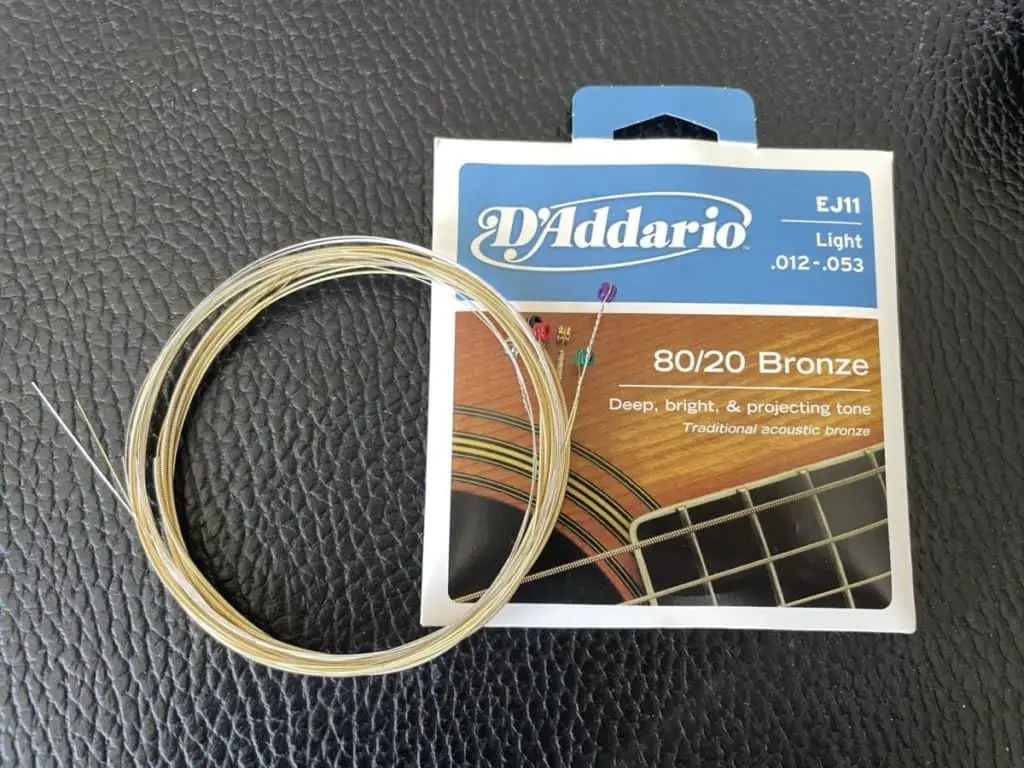
After installing a new set of strings on your guitar, you’ll want to stretch them to speed up the break-in process. To do so, check out our article on properly stretching your guitar strings for some tips as well as a video tutorial.
3. Frequently Bending Your Strings
Some music genres and songs are known for a lot of tremolo and diving notes (think Eddie Van Halen). Achieving these cool effects does place a lot of stress on your strings however. Frequent bending will cause your strings to stretch out much faster, speeding up wear and tear.

If your playing style incorporates a lot of string bending, your strings are going to lose their elasticity quicker and become loose, struggling to hold a tune. This process happens even faster if your guitar has a Floyd Rose bridge: this bridge constantly changes the string tension and stretches them at the bridge as well as along the fretboard.
Well, there really isn’t a fix for this one. If you love the sounds you can achieve with a Floyd Rose bridge and tremolo arm, keep shredding that way! Just know you’ll need to tune your guitar more frequently.
You can mitigate these effects by replacing your strings regularly. You could even choose a set of heavier gauge strings that are more resistant to stretching, though this would also impact your guitar’s tone and may not be desirable depending on the kind of music you like to play. But it’s an option to consider.
4. Frequent Drop Tuning
Your guitar might be going out of tune quickly because you frequently tune it down. This is a common technique in many music styles, but is especially prevalent in hard rock and metal, and may include tuning down every string or just the lowest string.
It’s not necessarily the act of down tuning that will cause your guitar to go out of tune faster, but the frequent changes in string tension as you tune to different pitches. This places more stress on your strings over time and will cause them to wear out faster.
Just like frequent string bending, there’s really no way to avoid the effects of drop tuning if the music you like to play requires it. You just need to be on top of replacing your strings before they get too old and worn out.
You can also choose a heavier gauge string set that better resists changes in tension. Some strings are designed specifically with drop tuning in mind, and may be worth a look.
5. Loose Tuning Pegs
Tuning pegs let you tune your guitar, but they’re also responsible for keeping your guitar in tune.
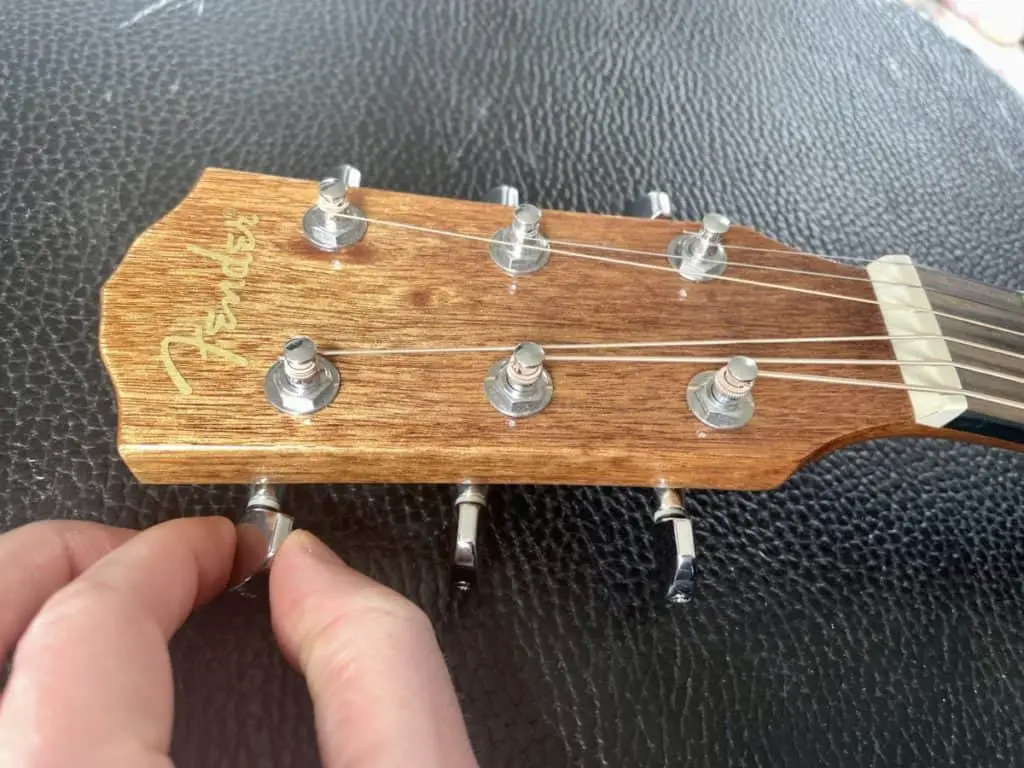
Rotating the pegs tightens or loosens the string tension, adjusting the string’s pitch up or down. But once you’ve achieved the desired pitch, those tuning pegs are supposed to remain in place. If they don’t stay put, they can’t effectively keep your strings tuned.
Loose tuning pegs can cause string slippage, where the strings loosen and unwrap themselves from around the peg. A guitar with broken tuning pegs just won’t stay tuned very long, especially if your playing style is aggressive or involves a lot of string bending.
Broken or loose tuning pegs that can’t be tightened will need to be replaced. And if you aren’t using locking tuners, this would be a good time for an upgrade.
Locking tuners feature a hole tapped through the retaining pin on the guitar headstock which the string is inserted through before it’s wrapped around. This helps keep the string tight and in place without requiring it to be wrapped around the pin so many times, which can lead to breakage.
6. Nut is Not Cut Properly
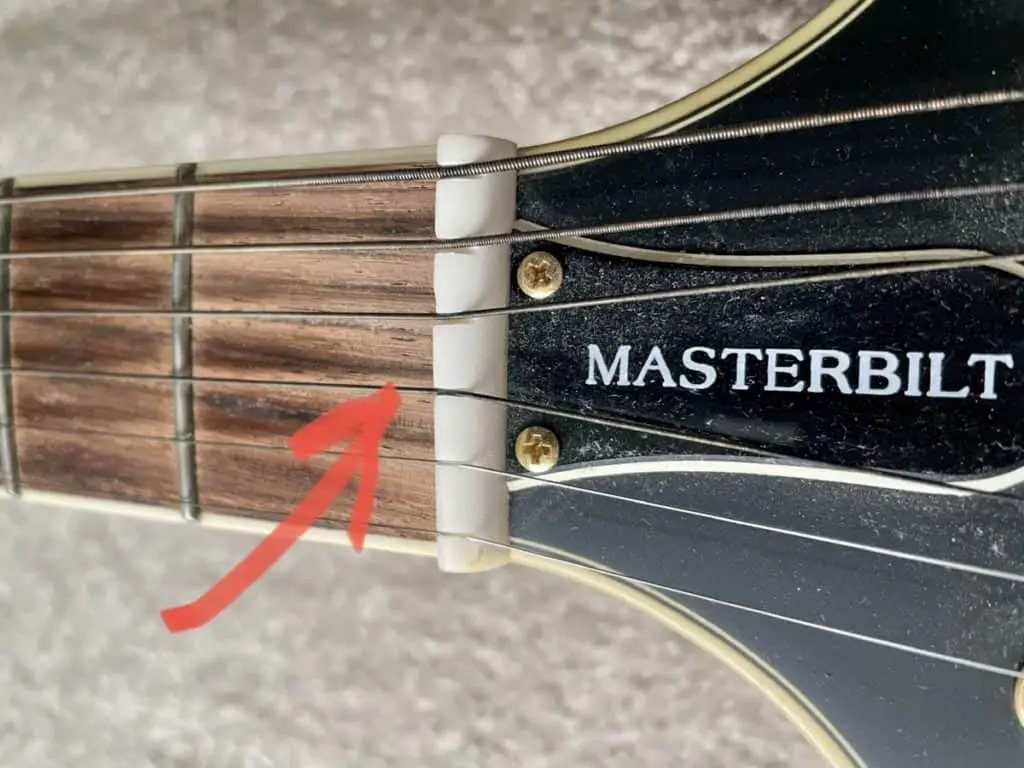
The nut holds your strings in place as they stretch from the guitar headstock down the fretboard. Without the nut, your strings would be able to slide back and forth across the fretboard. The nut also keeps them at the right height above the fretboard to make playing notes possible.
However, if the spaces in the nut that hold the strings are not sized correctly, they can increase string tension, which can cause them to go out of tune.
You may be able to adjust the size of the gaps with a file, but if you’re not comfortable doing this, it’s a good idea to have a professional do it for you. If the nut is worn down too much (which can happen, as the strings produce friction at this point), it might need to be replaced.
7. Improper String Tension
Strings need to be tensioned at just the right level to produce a certain pitch. Aside from the tuning pegs, there are other ways your string tension could be affected, and not in a good way.
The first occurs at the bridge. The height of the bridge is adjustable, which alters the height of the strings above the fretboard and pickups. If your bridge is too high, it will place excess tension on the strings and make fretting notes difficult. Too low, and fretting notes becomes easier but tension may not be enough to keep the strings elevated off the fretboard.
The second occurs at the guitar neck. A guitar neck may have a degree of natural bend to it, but excessive concave or convex bend will impact string tension. Additionally, this could put too much stress on the neck, causing it to break.
Improper string tension caused by either of these factors will make it more difficult for your guitar to hold a tune.
To adjust bridge height, turn the bridge screws to raise or lower the strings above the fretboard. Make sure you turn both screws evenly to raise or lower both sides of the bridge the same amount. Consult your guitar manufacturer’s website to find the proper bridge height for your specific guitar model.

Adjusting the bend of your guitar neck requires accessing the truss rod. For more information, see this article which describes how to find and adjust the truss rod .
This is something you really want to get right: turning the truss rod too much can place more stress on your guitar neck and damage it. If in doubt, take your guitar to a professional and let them take care of it.
8. Drastic Climate Changes
Guitars can be very sensitive to temperature and humidity. Drastic temperature swings and exposure to excess humidity or severely dry conditions can cause a guitar to swell, contract, or separate at its joints.
As the wood of your guitar swells or contracts, string tension will be altered, which can cause it to go out of tune. If your guitar has been irreparably damaged or its shape has been altered, it may not be able to hold a tune anymore.
Properly storing or transporting your guitar to prevent exposure to less than ideal weather conditions is the best way to keep humidity or temperature swings from causing harm.
Check out these articles for more on how to protect your guitar from humidity and moisture and how to keep it safe from cold temperatures .
How Long a Guitar Should Stay in Tune
How long a guitar should stay in tune depends on a number of factors: how often you play, your playing style, the type and gauge of strings you use, and whether your guitar has a Floyd Rose bridge.
It’s hard to say how long you can expect your guitar to hold a tune without specifically identifying the factors above. However, if you find your guitar seems to be out of tune every time you pick it up to play, there’s probably an issue that needs to be addressed.
A guitar should be able to hold its tune for at least a couple of practice sessions, assuming you practice regularly.
How Often Should You Tune a Guitar?
This one’s a little easier to answer: whenever it sounds out of tune!
If your playing sounds a little off, it might just be that your guitar needs a quick tune. Nothing can ruin a good song and make you doubt your playing skills like an out of tune guitar.
If you frequently tune to different pitches to play different songs, then you’ll obviously be tuning more often; possibly after every song if that’s how you’ve structured your practice.
4 Tips to Keep a Guitar in Tune Longer
1. buy high quality strings.
A good set of strings will not only sound better, but they’ll hold their tune much longer than cheap strings. Even high quality strings are relatively cheap (compared to the price of a guitar) so there’s no reason not to spend a few extra dollars.
2. Properly Adjust Guitar
But, even good strings won’t sound good if your guitar isn’t properly adjusted.
This means making sure the bridge height is correct, the neck angle is set correctly to provide the right string tension, and the tuning pegs are tight and holding the strings in place.
3. Store Your Guitar Properly
Guitars do best at a temperature between 70-75 degrees Fahrenheit and a humidity between 40-50% : this keeps the wood from getting too hot or too cold and causing damage. Ideally you want to store your guitar in these conditions. Depending on where you live, this might mean investing in a humidifier or dehumidifier.
If you’re transporting your guitar, keeping it in a hard case is best. Hard cases regulate temperature better and provide more insulation than a gig bag. You can also buy a guitar case humidifier if you’re traveling through a cold, dry climate. This will keep your guitar at the proper humidity and prevent the wood from drying out and cracking.
4. Buy a Tuner
It’s hard to keep your guitar in tune if you don’t know how to properly tune it in the first place!
It takes a lot of practice to tune a guitar by ear. If you’re not there yet, there’s nothing wrong with buying a tuner (or using a tuner app on your phone). This ensures your guitar is always in tune, which will make your playing sound way better.
It will also keep you from constantly adjusting your strings when the songs you’re playing don’t sound quite right. Frequently fiddling with the tuning pegs and altering string tension will only make your strings wear out faster.
The Fret Folks Team
Recent Posts
Is Mitchell a Good Ukulele Brand? (Reputation, Quality, etc.)
Today I’m going to give you an in-depth rundown of Mitchell ukuleles and answer whether they are a good brand or not. I own a Mitchell MU-100CE/N and it’s an eye-catching, great sounding, and...
17 Reasons Guitar is Harder than Piano (for Beginners)
There’s no question that piano and guitar are both daunting instruments to learn. But which is harder to tackle as a beginner? Generally speaking, guitar is harder to learn than piano for...

Fender Play The #1 guitar learning platform TRY FOR FREE
1 Min Read By Mike Duffy Share
Why Do Guitars Go Out of Tune?
The 7 most likely culprits keeping you from staying in tune.

One of the annoying things guitarists at any level face is an instrument that won’t stay in tune. Whether on stage, in the studio or just in the bedroom, those pesky strings can slip out of tune in an instant, and typically at the most inopportune times.
Why do guitars go out of tune? Here are seven everyday issues to consider:
1. The Strings
It might sound simple, but old strings can keep you from that perfect tuning. As they wear, they lost their capability to hold tension, making them feel brittle and less able to hit the fret. That will make some notes to sound sharp.
2. The Climate
Guitars and their strings are greatly affected by extreme changes in temperature , as they will expand when it’s warm (making it sound flat) and contract when cold (resulting in a sharper sound).
3. The Capo
A poorly placed capo can mess with your tuning, pulling the strings down towards the fretboard when attaching it and pulling them across the fretboard when taking it off. Be careful with that capo !
4. The Intonation
A guitar must be intonated right or it’s not going to tune properly. Poor intonation can be solved by adjusting the truss rod that runs down the center of the guitar’s neck. You may also have to adjust the height of the bridge and/or nut to achieve ideal action.
5. The Tuning Machines
Wear and tear on a guitar can loosen its tuning pegs to the point that they won’t hold a tuning. Using a screwdriver to tighten then every so often will ensure the tuning machines are attached enough to the headstock and keep you sounding right.
Each string moves through a slot in the nut at the top of the fretboard, and if they’re not moving through that slot smoothly, the result is tension on one side or the other . If the strings don’t sit in those grooves along the nut’s front edge as they move down the fretboard, you’ll be out of tune throughout the neck. The nut slots might but cut too narrow or shallow for your string gauge, which makes the string bind. You can alleviate this by using a file to address the grooves, or using a form of lubrication.
7. The Tremolo
Every time you press the tremolo arm , the strings gain a little slack, and if they are wound sloppily to the tuning pegs, you'll eventually sound funky. The same goes for when you pull on the vibrato, as it will increase pitch in the strings. This eventually relates to the nut, as movement of the strings can cause them to change position in the nut and affects the way they retun to pitch.
Click here for a full assortment of Fender electronic tuners and here to download the Fender Tune app . And if you'd like to learn more about your guitar and tuning, sign up for a free trial for Fender Play here .
Don’t miss out!
Be the first to know about new products, featured content, exclusive offers and giveaways.
Related Articles

Introducing the Tom DeLonge Starcaster
- #tomdelonge
- #starcaster

Strat Sessions: Buddy Guy Featuring Christone “Kingfish” Ingram
- #stratocaster
- #christone “kingfish” ingram
- #muddy waters

Introducing the Fender Next Class of 2024
- #fender next
Why Your Guitar Sounds Out of Tune, Regardless of What Your Tuner Says
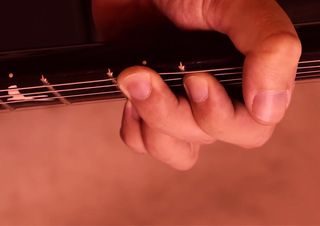
The easiest mistake to make as an eager, developing guitarist is to neglect the basics in our later stages of experience. Learning and mastering an instrument is all about peaks and valleys. Certain days, you’ll feel like you’ve taken a huge leap in your proficiency, while other days you’ll feel like you just can’t play anything right.
Even though this is an unavoidable reality we all deal with, there is a way to make the valleys (times when you’re not playing well) less frequent, not as deep and easier to climb out of. The solution is being mindful of various fundamental techniques that will lead us to those towering peaks of guitar playing glory.
There are many different ways this lesson could go, but one of the most common issues I find with my students is that they’re not always in control of their finger strength. This results in out of tune notes and chords, which can be extremely frustrating, especially for more advanced guitar players who thought they’d never have to deal with such elementary matters again.
Luckily, a simple adjustment of the torque you’re putting on the neck is all you need to get back to normal. In the video below, you’ll notice the image turn from a red hue (indicating incorrect chord playing) to a normal image as I reduce the force from my fingers on the frets.
The point of this article is not necessarily to show you how to play chords properly; a lot of you are advanced and capable players who don’t need a beginner lesson like that. The main takeaway is to always be conscious of the little intricacies that make up a great guitar player: bending in tune, proper vibrato, solid time and intonated chords, among others. When you’re wary of these rudiments, you’ll put yourself in a position to improve your skills faster and more consistently than ever before.
Tyler Larson is the founder of the guitar-centric brand Music is Win . His insightful, uncomplicated guitar lessons and gear demonstrations along with entertaining, satirical content about life as a musician receive tens of millions of video views per month across social media. Tyler is also the creator of the extremely popular online guitar learning platform, Guitar Super System. A graduate of Berklee College of Music, Tyler has been teaching guitar for over a decade and operates a production studio in Nashville, TN.
Thank you for reading 5 articles this month**
Join now for unlimited access
US pricing $3.99 per month or $39.00 per year
UK pricing £2.99 per month or £29.00 per year
Europe pricing €3.49 per month or €34.00 per year
*Read 5 free articles per month without a subscription
Prices from £2.99/$3.99/€3.49
Get The Pick Newsletter
All the latest guitar news, interviews, lessons, reviews, deals and more, direct to your inbox!
Tyler Larson is the founder of the guitar-centric brand Music is Win . His insightful, uncomplicated guitar lessons and gear demonstrations along with entertaining, satirical content about life as a musician receive tens of millions of video views per month across social media. Tyler is also the creator of the extremely popular online guitar learning platform, Guitar Super System. A graduate of Berklee College of Music, Tyler has been teaching guitar for over a decade and operates a production studio in Nashville, TN.
He recorded with Bob Dylan, toured with Tom Waits and replaced Jimmie Vaughan: Duke Robillard is American blues guitar royalty
John Mayer and Kenny Wayne Shepherd are two of the biggest names in modern blues – and boy, do they know how to introduce a guitar solo
“There isn’t much guitar at all for the first three tracks. Nobody gave me the memo about what a record should sound like”: How Steve Vai revolutionized guitar with his debut album, Flex-Able
Most Popular

Maret Guitars – Reclaimed Wood Custom Guitar
Making a brass nut
Nov 22 2020
Your guitar is out of tune. Deal with it.
- By Benjamin Strange
22 November, 2020
“Intonation is a social construct.” If you’ve hung around our shop long enough, you’ve probably heard me say this, as it’s one of my favorite aphorisms. What do I mean by this, and what does this have to do with your guitar? Well, your guitar is out of tune. In fact, EVERY fixed pitch instrument is out of tune, and probably every song you’ve ever heard is out of tune. You’ve just gotten used to how it sounds, and maybe have never considered that music could sound any other way. Have you ever tuned your guitar to a perfect G major chord, only to discover that now your E major chord sounds horrible? Why do you have to sacrifice a perfect G major to make your E major palatable? The short answer is that your guitar is out of tune, and always will be, and you just need to learn to deal with it. The long answer, my friends, is this:
Music, at it’s most fundamental level, is math. Math doesn’t just dictate rhythm, but it also dictates pitch: musical notes are essentially oscillations of air pressure, creating a waveform that we measure in Hertz (Hz), which is one wave cycle per second. The most basic waveform is a sine wave, which is the fundamental tone of any note.
Our brains perceive the frequency of these waves as pitch. Faster vibrations we hear as a higher pitch, slower vibrations lower. (For example, a note measured at 200Hz will be heard as lower than a note measured at 400Hz.) The relationship between these vibrations and how we combine them is what we call harmony.
How do we tune a guitar, or any other musical instrument? We measure the difference between one vibrating string and another, and shift one note to perfectly match the sound of the other. This process is essentially seeking out the simplest ratios between one frequency and another. Simple ratios sound pure, like the two notes blend in perfectly with another. More complex ratios sound discordant, and are prone to cause some eye-twitching with the more golden-eared crowd.
The most basic of ratios is a 1:1, meaning one note’s freqency is exactly the same as another. Here’s two notes, both simple sine waves, at 200Hz (about the same pitch as a G string):
If those notes were out of tune, the two waveforms would be out of alignment, amplifying some parts of the wave while reducing other parts, which our brains perceive as being out of tune. Here’s the same root note of 200Hz, but with the second tone getting progressively more out of tune, at 202Hz, 204Hz, 206Hz, and 208Hz:
Do you hear how each example pulsates faster than the one before it? Did you get that sickening feeling in the pit of your stomach? Congratulations, you CAN hear when things are out of tune! You’ve got a better ear than you thought!
Most musical instruments can play more than one note, so the 1:1 tuning method isn’t exactly useful. To tune beyond a single note to itself, we have to use a more complex ratio, 2:1. This relationship we call an octave: one note is vibrating at twice the frequency as the other, making it sound twice as high. With one root note, we can tune one octave to another, and then another, and then another, using the 2:1 ratio applied to each new note: 200Hz to 400Hz, 400Hz to 800Hz, 800Hz to 1600Hz, etc. Octaves blend together almost perfectly, with each note almost vanishing into the other. Here’s two notes, one at 200Hz, the other at 400Hz:
Again, music is made up of more than just octaves. If it were, our music would be incredibly boring – imagine singing the first two notes of “Somewhere Over The Rainbow” over and over and over again. Our music demands harmony, which means more complex ratios: the next simplest ratio is 3:2, which gives us what we call a perfect fifth. The notes in a fifth blend together almost seamlessly, yet each note can be heard independently if you listen closely. Here’s a perfect 5th , with 200Hz and 300Hz being played:
With a somewhat more complex ratio of 3:2, we can now start tuning other notes beyond the root and octave, and actually create more complex harmonies. If we stack 3:2 ratios, over and over again, we can tune all kinds of notes: 200Hz to 300Hz, 300Hz to 450Hz, 450Hz to 675Hz, etc. A fifth on top of a fifth on top of a fifth, which we have come to call the circle of fifths . We’ve applied simple names to these frequencies, so starting from 200Hz, which is approximately a G, we can now tune G to D, D to A, A to E, E to B, and all the way back around until we get to a G again (albeit in a different octave). Perfect, right? Wrong.
Ideally, stacking a perfect fifth twelve times would circle back around again to our beginning note, allowing us to tune every note in the scale. Mathematically, however, it just doesn’t work out that way. Stacking perfect fifths twelve times can be represented as (3/2)^12, which give us roughly 129.75, which is close, but not quite, equal to seven octaves: 2^7=128. This means that while each individual fifth is perfect, our octaves are out of tune with each other, and so is every other interval! Gah! Madness!
Going back to our original 200Hz tone, applying the above formula, our two “identical” notes now sound like this:
While this may not seem too bad, remember that most music comprises of more that just two notes, and the more out of tune notes are mixed in the worse it sounds. The impure ratios compound upon each other, leaving us with an unholy mess of discordant sounds.
So what’s to be done? It is mathematically impossible for your guitar to be perfectly in tune. Over the last several hundred years, musicians and theorists have gone to great lengths to attempt the impossible: developed instruments with lots of extra keys and frets, different tuning systems, and got into a lot of heated debates, seeking the perfect tuning system where every interval is pure. Eventually everybody just kind of gave up and settled on 12-tone Equal Temperment . This system essentially robs Peter to pay Paul: the entire scale is squished, flattening every half step so the octaves line up. This “tempering of the scale” is referred to as the twelfth root of two , or 12√2. Every half-step is now slightly flat, and every interval is slightly out of tune – no pure fifths, no perfect thirds. Bach would not be pleased .
What does all this mean for your guitar? Well, first of all, you need to accept that your instrument will never be perfectly in tune, and that’s ok. If you listen closely, The Beatles were horrendously out of tune, and it didn’t stop them from being the best band in the world. Our best hope for our guitar is to make them as evenly out of tune with themselves as possible. They key to this is a good setup – if your guitar isn’t set up properly, no amount of fiddling with the intonation is going to help. In fact, we set the intonation on guitars at the very end of the setup process. A well intonated guitar will have it’s nut cut low, have string action close to the fretboard, use strings that aren’t overly light, and perfect fretwork . Intonating a guitar is done by lengthening or shortening each string to compensate for string size, pitch, and scale length. There’s quite a bit to be said about the mechanics of intonating a guitar, which we will save for another time.
You can make improvements to your intonation at home. First of all, after making sure your guitar is properly set up, get a decent electronic tuner. Don’t simply trust your ears – remember, you’ve been listening to out of tune music your whole life and you didn’t even notice! If you find yourself in a pinch without a proper tuner, tune the guitar to itself by fretting the note of the next open string – do NOT use the harmonic method , which is mathematically incorrect. Don’t try to tune your guitar by tuning to a chord: your ears can fool you, and if you get one chord perfect, the rest of your other chords will be off. Also, be mindful of your technique: if you squeeze the neck too hard, or are too aggressive with your attack, you will bend the strings and push everything out of tune. Intonation is in your hands as much as it is in your head.
Or you could, you know, just put together a fretless Strat like I did.
If you’d like delve further into intonation and the history of our current tuning systems, I highly recommend to start with Temperament: How Music Became a Battleground for the Great Minds of Western Civilization Kindle Edition , by Stuart Isacoff. I also recommend The Fifth Hammer: Pythagoras and the Disharmony of the World , by Daniel Heller-Roazen. If you have any questions, feel free to contact me at [email protected] .

Benjamin Strange
I am a bassist, guitar tech, and founder of Strange Guitarworks. When not working on guitars, I create experimental music under the moniker of UFO Death Cult, utilizing microtonal instruments of my own design.
"Intonation is a social construct."
Permanent link to this article: https://www.strangeguitarworks.com/guitar-is-out-of-tune/
Recent Posts
- Bar Refret on a Vintage Martin 4 March, 2024
- The case against Fender’s Micro-Tilt 16 January, 2024
- Fretting a fretless bass 13 November, 2023
- Repairing a Floyd Rose route 3 October, 2023
- PLEKing a multiscale guitar 18 September, 2023
strangeguitarworks

© 2024 Strange Guitarworks.
Made with by Graphene Themes .

- Child Development
- Activities for Kids
- Homeschooling
Home » Music » Why Do Guitars Go Out Of Tune?
Why Do Guitars Go Out Of Tune? 5 min read

When we listen to live Guitars some Guitarists produce the best music while some really sound awkward or the Guitars sound really odd. Do you know the reason? If you are a beginner, learning to play the Guitar be cautious about the Tuning of Your Guitar. Most of the budding guitarists do not tune their guitar every time they practice. This can diminish their progress as a guitarist and it can also cause them to have poor aural skills which lead to poor confidence in playing the Guitar. Having the proper tuning of your guitar is very important during this stage of your guitar learning. It will help you learn how to play smoothly and effectively. Having this technique will help you avoid getting used to playing out of tune also to avoid embarrassing situations too!
Know why tuning the Guitar is important
It can be frustrating to play with a guitar that won’t stay in tune. Getting your guitar in tune is very important for playing well. It helps keep it in tune and produces consistent playing. There are a variety of factors that can affect your guitar’s tuning. Fortunately, there are a number of common causes of tuning problems that can be easily solved.
Here are a few underlying causes and resolutions.
Climate that changes everything
Humidity and temperature can also affect the tuning of a guitar. High humidity levels can cause the wooden components of the guitar to expand, which could result in a flat tuning. Under ideal conditions, the humidity and temperature will cause the components of your guitar to contract, which means the tuning will go sharp. Keep a check on the climate and always keep your Guitar in the Guitar case to avoid contact with humidity and the air.
Pretty Old Strings:
When it comes to guitar strings, they will eventually sound worse as they get older. This is because as they get weaker, they become harder to fret.
You can change your strings once they start displaying the following conditions.
- Dull sound & lack of sustain
- Poor tuning
- Difficulty to fret
- Grimy or dirty appearance
- String breakages
New Strings that are not Stretched well
Most of the time, guitarists don’t realize that stretching in new strings is important. When they first start playing, they tend to tire themselves out if they are not stretched well.
Every time you buy a new set of strings for your guitar:
- Tune the string to pitch
- Place your index and middle fingers underneath the string at the 12th fret and pull upwards
- Re tune the string to pitch (it almost certainly will have gone flat)
- Repeat the process at the fifth fret
- Continue to stretch the string until there is no noticeable tuning difference after stretching
- Repeat the entire process for the other strings
The Intonation
One of the many reasons for Guitar to go out of tune is when the intonation of the guitar doesn’t sound right, then it should be tuned properly. That is most probably when the open strings are in tune but the fretted notes are out of tune, it’s likely that you have poor intonation.
Here are a few tips to resolve it:
- Tune an open string to the proper pitch using a goo tuner
- Play a fretted note on a string at the 12th fret, and if it is sharp, the bridge saddle should be moved away from the head-stock. If the note is flat, then the bridge saddle should be moved toward the headstock. If it is angled, then adjust the bridge saddle screw.
- Repeat the process until there is no noticeable difference in tuning between the open string and the fretted note
- Do the same thing with all the other strings
Guitars going Nuts because of the Nuts!
A loose nut can also cause a Guitar to malfunction. This issue can also cause it to go out of tune when it gets bent. If the cut-out nut is too narrow, it prevents the string from freely moving. If the nut is still causing problems, try using a pencil to grease the slots with graphite. This will help keep the problem from happening again.
The Quality Matters
The quality of your guitar string is also very important to the longevity of your guitar. For instance, if your guitar has a built-in tuner, it should always be tuned to the correct tuning tone. Also in most cases, it is not uncommon for guitar techs to see that the string is bent or twisted right out of the box. When it comes to string size, note the size of the guitar you bought. Doing so will help you determine the proper fit for the instrument. You might also want to consider an adjustment to the bridge or the intonation adjustments. So checking the quality of the Strings and position is equally important.

Keep a check on the Pickup Height and the Bridge
Sometimes, a pickup height or bridge issue can cause tuning difficulties. If it does, try loosening the screws on the bridge to see if they have worked themselves loose. Also, try playing with a pickup magnet that is a little high to prevent it from pulling out the strings.
Poor Techniques
If you still sound out of tune after trying various techniques, it’s likely due to your own technique. There are a few common causes of this issue that can affect your guitar. Over-tension or under-tension can also cause poor string bending. Using the Whammy bar frequently can also cause some tuning stability issues in some cases.
Also, consider consulting a Professional Guitar Luthier for help if needed. Getting your Guitar tuned is equally important when you start your Guitar lessons. Always check if the Guitar is tuned well before even starting your warm-up exercises. So a well-tuned guitar will make playing more enjoyable. It will also sound better and be more durable. Having fun with the guitar will make it much easier to learn.
Aside from improving your guitar’s sound quality, tuning also helps train your ear to hear the right notes. It’s also a great way to fall in love with the instrument. Learning to play music is one of the greatest things a person can experience.
Get ready to groove!

Music Production For Kids – 11 Tips To Get Your Kid Started
15 Reasons Why Your Child Should Learn Piano At A Young Age
our mission is to make co-curricular learning fun for kids in a secure, select, collaborative community
Get in touch:
USA: 4, 1107 High School Way Mountain View, California
UAE: Executive Towers, Tower J, No. 905, Business Bay, Dubai
Australia: 13 Madison Boulevard Mitcham Victoria Australia - 3132
India: DD3, Diamond District, HAL Old Airport Road, Bangalore
Allround is a brand owned by Allround Development Private Limited and is covered by Privacy Policy and Terms & Conditions.

Why Acoustic Guitars Go Out Of Tune

Keeping your guitar in tune is a chore that never really goes away, even the seasoned professional musician who knows every factor that contributes to tuning instability still has to deal with this frustrating issue.
But it’s even worse if you are a newer player and can’t find out what exactly is causing your guitar to go out of tune. While some things a local guitar technician can help with, others you just need to be aware of and can introduce some simple practices into your string changing/cleaning routine to help keep your guitar playing as well as it possibly can.
“Take care of your instrument and it will take care of you”
So today we’re going to cover all the primary contributing factors that will make your acoustic guitar difficult to keep in tune.
Old Strings

Old strings are usually the first thing people will mention when it comes to dealing with tuning issues, and you’ll quickly be encouraged to swap them out for a new set to solve many of your common pitch-related woes.
The factors that play into this are often quite subtle, but over time they can accumulate to some fairly noticeable tuning issues.
As we play guitar strings, despite our best efforts to keep them clean and wipe them off after each play session (you are doing that, right?) they will slowly build up oils, dirt, and grime. The acids on your hands will oxidize and corrode the string, the rubbing against the frets and the pick striking the strings.
All these things can be broadly summed up as ‘wear’ on the string, and irrespective of the loss of tone, that damage can cause tuning issues, particularly when it comes to intonation.
You might find your open E note rings out just fine, but by the time you get up to the 12th fret, it could be as much as 50 cents out of tune!
On acoustic guitars, this is particularly hard to address as bridge adjustments are not a simple turn of a screw away.
The simple solution to this is just to put some new strings on your guitar. There’s no pre-determined schedule when it comes to how often you should change strings . Over time you’ll get a feel for when the tone starts to sound dull and it becomes more difficult to keep in tune. Use that as your cue to swap them out.
New strings

Then as soon as you put new strings on you’re immediately faced with a new issue! But don’t worry, this one’s much easier to deal with.
Guitar strings stretch a lot, particularly when they are new. And although some manufacturers will pre-stretch the strings they will inevitably still stretch once brought up to pitch and under full tension.
The simple solution to this is after you have tuned your instrument, lightly pull up on the strings all the way from the nut to the bridge, do this on each string to help work that extra ‘give’ out of them.
Once you do that you should find everything is flat, tune it up again and it should hold its tuning much better! If not repeat this exercise 2-3 times and your strings should start behaving.
Incorrect intonation

If you find that even though your open notes are tuned perfectly, as you climb up the neck it slowly gets more and more out of tune, there’s a good chance your guitar’s intonation is off.
On an acoustic guitar, we don’t have individual bridge saddles to control intonation, they use much more of a “set and forget” kind of construction. So what you can do here is visually check the bridge to see if it’s seated correctly, or if it is leaning forward or backward? Has the glue worn down which has made it lean a particular way? Unfortunately, this is oftentimes not an easy DIY fix, and unless you are already quite confident with what you are doing we recommend taking your guitar to a local store to let their guitar technician take a look at it.
Tuning pegs

There are 2 main reasons why the tuning pegs contribute to tuning issues, and they’re both equally as common.
The first is because something has come loose. Usually, a screw which is allowing the tuner to rotate outside of the intended mechanical movement.
Every time you change strings and clean your guitar, we recommend giving all your tuning pegs the once over and just making sure all those screws are tightened down.
The other factor is just generally low-quality tuning pegs, they might naturally slip, and maybe they don’t hold the string properly. Sometimes upgrading the tuning pegs on your instrument to higher quality ones can increase your tuning stability.
String Slippage
There are two things to keep in mind when attaching a string to a tuning peg that will give it the best possible chance of keeping in tune.
1: Don’t overwind the string
Manufacturers will often give you a ton of extra string to account for things like baritone instruments. You don’t actually need to use all that excess, and winding the string too many times around the tuning peg leaves extra material that, over time, will continue to stretch. This can give you the prolonged issue of the string consistently drifting in its tuning.
The solution to this is to use the smallest number of windings possible so there’s as little material there to continue stretching and slipping over time. We recommend 2 to 3 winds around the peg for an acoustic guitar. Then just trim the excess off with some clippers.
2: Wrap the string
Acoustic guitars don’t generally have anything mechanically in place to lock the string into the tuning peg, it usually just relies on the tension of the string to hold it in place.
But these are smooth strings held onto a smooth tuning peg, they will inevitably slip over time. One possible way to counter this is to ‘wrap’ the string over itself when re-stringing to essentially emulate what a locking tuner on an electric guitar aims to achieve.
To do this you thread the string through the peg as normal, but then turn it around and feed it over, then under where the string first enters the peg. Then tune it up to pitch as normal.
This will act as a ‘lock’ to keep the string held in place and stop slippage.
Worn out or incorrectly cut nut
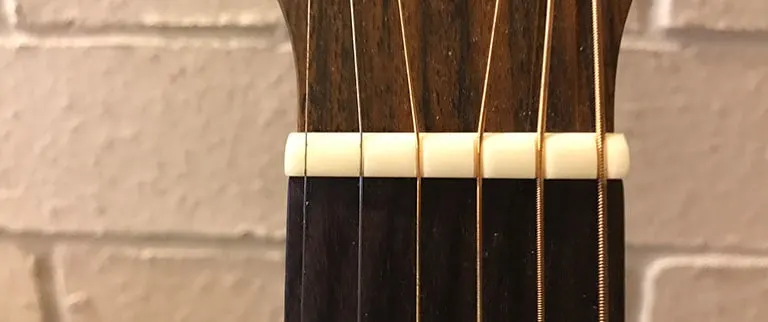
The nut sits right at the base of the headstock and acts as 1 of the 2 termination points for string vibration.
To ensure the string vibrates perfectly between the nut and the other termination point (the bridge) which is paramount for the string to vibrate at the correct pitch and produce the correct note, it needs to fit that string nicely and snugly.
As people like to experiment with different tunings and string gauges you will quite commonly find the nut to be the culprit of some tuning issues for 2 main reasons.
The slot not being the correct size to fit the string
If the nut’s ‘slot’ can’t quite seat the string it will end up being suspended in the air just being pinched on either side, which results in a whole host of tuning issues.
Primarily because when a string is ‘suspended’ in the nut, it’s actually lengthened the string slightly which is going to make it impossible to intonate and tune correctly.
Not only that, but it’s also going to make your string action higher. Which just, in general, will make your instrument more difficult to play, but that additional travel time the string takes to reach the fret adds additional tension to the string, making notes go sharp.
Needless to say, making sure the string is seated snugly in the nut is pretty important!
Tight Nut Slots
Another issue this causes is if the nut doesn’t provide a smooth surface for the string to travel over.
This is where you tune your string up, and up, and up, and it seems to not change pitch, then suddenly you’ll hear a PING, and it’s now completely sharp. This is because the nut is gripping the string and not allowing it to raise pitch smoothly, it’s only when the tension is too much that the string will break free of the nuts grip, and by then you’re already too sharp.
You can use ‘nut oil’ to help lubricate the nut and help the string travel smoother within it, although this needs to be used fairly infrequently as going overboard here will just gum up the strings. Another option is to use graphite to lubricate the path for the strings. To do this simply take a sharp pencil and run it between the nut slots as per the image below.
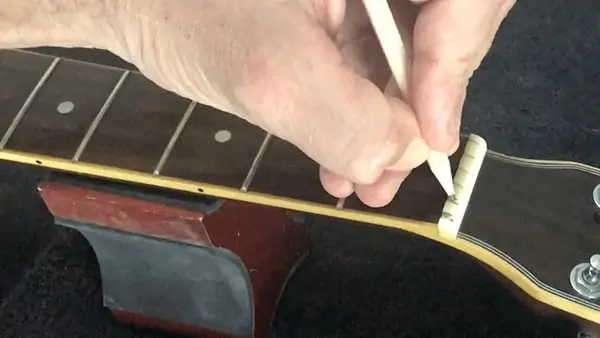
Temperature and humidity
This one is hard to avoid, but keeping aware of its effects can help to inform you of why your instrument is struggling to hold its tuning.
High temperature and high humidity will make wood expand, likewise, cold weather and low humidity will make it contract.
So traveling, or getting the guitar out from cold storage and suddenly standing on a hot stage is going to wreak havoc with the stability of the instrument.
There’s no real magic trick with this, just use common sense. If you know your guitar has been in a cold place give it some time to come up to temperature and adjust before tuning it.
Humidity can be much more difficult to control and is particularly important when storing your instrument . If you store it in a place with high humidity for too long your acoustic can suffer some real issues such as the bracing or neck warping.
Some people get very meticulous with managing humidity, but I’d just recommend if you know the place you most commonly store your guitar experiences high humidity. Consider sticking a dehumidifier in there to manage it a little.
Some acoustic guitars have the strap attached to the headstock, and no matter how well built your instrument is, the weight your arms exert on the instrument as you play essentially makes that strap act like it’s pulling up on the headstock.
This can very easily bend the neck and make notes go sharp. Where possible it’s best to have your straps two points of contact attached to the body as it’s a much more robust and stable location that’s less susceptible to bending.
Poor capo placement

A fairly easy one to solve, but it’s also one that if you aren’t aware of it can be the cause of some major headaches!
The capo should be placed right behind the fret, it can even be touching the fret ever so slightly.
The main reason for this is because when the capo is placed in the center between two frets, the pressure provided by the capo can actually make the string ‘sink’ into the fret more, which makes every string go slightly sharp.
This effect is essentially nullified when the capo is moved right behind the fret wire itself as it acts as a support for the string to stop the capo from depressing it too much.
Much in the same vein as the capo issue, if you press too hard on the strings or are unintentionally bending the string up when holding some particularly awkward chords. This will result in your acoustic going out of tune, usually sharp.
So try to keep an eye on what your hands are doing and look for any scenarios in which you might be disturbing the natural ‘line’ of the string.
Only tune up, never tune down
Finally, we will leave you with a good general practice which is when you tune your instrument , only tune it up to the pitch from below.
If you accidentally go sharp and need to flatten the note, flatten it to quite a bit below the target pitch and then go again and approach slowly tuning up to pitch from below.
The main reason for this is tuning down creates slack in the string and around the headstock, and no matter where you land as you play and work out that slack from the string you’ll find it will continue going flat.
You don’t get this issue when tuning up. So a good rule of thumb is to tune down 1 semitone below your target pitch, give the string a little tug if you want to help work out that extra slack, and then slowly bring it up to pitch.
Final thoughts
So as you’ve no doubt gathered there are a lot of factors that can contribute to your acoustic guitar going out of tune.
While you certainly don’t need to commit all the information shared here to memory, it’s worth keeping this as a handy guide so if at some stage you find yourself faced with tuning issues you can reference back to this and hopefully find a solution to your particular issue!
Liam Plowman
How to stop your guitar from going out of tune
Getting tired of your guitar going out of tune?
We’ve all been there! Having your guitar slip in and out of tune to various degrees is both the bane of a guitarists life, and could also be the indication of a genuine problem with your guitar.
Let’s take a look over some of the ways that your guitar can go out of tune, and also what that could mean in terms of a larger problem!
10 reasons your guitar can go out of tune
Any guitar, even if you have a locking tremolo , is going to go out of tune at some point. And that’s okay. But if you’re experiencing tuning problems consistently over an extended period of time, then it will be best to have a look over the following points:
1. New strings haven’t had time to ‘settle’
I was initially surprised when speaking to other guitarists who didn’t know that it’s very common for a new set of string to slip in and out of tune. You need to give your fresh strings time to ‘settle’, and I usually do this over a period of a few days. That doesn’t mean stretching the life out of them either. The way I break my new strings in is split between:
- Legato – Repetitive hammer-ons and pull-offs to get the strings set against the neck
- Chord runs – I’ll play the same chord in several different shapes, meaning that nearly every note up to the top frets is given a look
- Playing until the tuning slips – I feel this is important as you can’t just play when the new strings are in tune. Ideally, you want to get to the point fairly quickly where your new strings are settled and you’re just having to do micro-adjustments so you can carry on playing in tune
2. It’s time for a string change
Old strings can be just as much of a problem as old ones. As strings age they can obviously become worn, and even reduce in density due to continual wear. The wear is one of the more common causes that will cause the tuning to slip, as the strings become more worn when in place within the nut.
Personally, I change my strings every 2 months. However, as a guitar teacher I’m playing at least 5 hours per day on and off, so this may be a little overkill for most players.
3. You leave it next to a radiator
Wondering if you can leave your guitar next to a radiator? Please, please don’t do this! Any level of heat is likely to cause even minimal warping, and could in fact cause serious damage to your instrument. Naturally, the first thing to slip will be the tuning, and if left long enough your guitar will also experience:
- A continual drop in pitch as the heat expands the strings
- Possible internal issues such as a metal casing or rod become heated and expanded, resulting in warp to the neck or body
Just let me say it again just to be sure (as I’ve learnt the hard way on this one). Keep your guitar away from continual heat, radiator or otherwise!
4. Constant Whammy Bar Use
The nut of your guitar can be surprisingly temperamental if it isn’t set up properly, and this is never truer when it comes to using your tremolo. Sustained use of the whammy bar will cause your strings to move around in the nut, and naturally become both slack and then tight in repetitive movements.
Ultimately, without a locking system like a Floyd Rose, the movement can cause your tuning to shift just purely based on the level of movement in the nut.
Having said that, if you’re experiencing a tuning slip every time you so much as lightly feather your tremolo, then you might want to get your guitar checked out by a professional.
5. Tone-down your playing intensity
This is a really common one for beginner players, especially when experimenting with something like a delay pedal and wanting to see how far effects can be pushed, or how loud they can play.
Naturally, your guitar can only take so much continual playing intensity. To put it lightly, if you’re truly decimating your guitar with every strum and experiencing a slip in tuning, it might be worth getting a teacher just to revisit technique!
6. Intense string bending
Bending itself isn’t usually an issue when it comes to tuning, but something like continual bends that exceed standard tonal jumps will naturally cause the string to slip in the nut.
This was something I experienced when going through my shredding phase (does it ever really end?), and after experiencing minor tuning slips I made the jump to a guitar with a locking tremolo system. Now, if you’re just experimenting, I wouldn’t recommend this, as a locking system comes with it’s own set of problems.
But, if you know you’re going to be doing things like constant whammy dive bombs and intense bends, then it might be worth checking a locking nut out.
7. Issues related to a floating bridge
A floating bridge is usually paired with a locking nut, and if its not set up properly then your tuning is likely to be all over the place. Most floating bridges will have micro-tuners that you can use, however you are very likely to experience tuning issues if you’re having to undo the locking nut to tune your guitar.
8. Your capo has seen better days
It’s easy to blame capo issues on general placement, but you might also be using one that is super old or just not suited to the neck of your guitar. Your capo is putting tension on the neck of your guitar, and one that is poor quality can very easily cause tonality and tuning issues. I’ve done a guide to capos if you’re stuck on where to start with buying one for your guitar.
9. Nut filing is required
If you’re the type of player who likes to experiment with different strings widths and gauges, then your nut is naturally going to see the wear and tear of constant changes and different sizes.
If you’re using something like 0.8 gauge strings on a guitar that originally came with something like 0.11’s, then you may need a nut filing to ensure that your strings ‘sit’ in place properly, ensuring that there’s no chance of your strings moving around the place and causing a tuning issue.
10. It might be time for a setup
As I play guitar every day for at least several hours a day, I get a full set up every 6 months. This includes nut cleaning, treatment to the neck, along with inspection of the frets (to stop that annoying fret buzz ) and setting of the action. I saved up for a PRS SE anniversary addition, there’s now way I’m not giving it the best treatment!
The easiest way to ensure your guitar stays in tune
Okay, so we’ve covered some of the more common reasons that could cause a slip in tuning, But, once your guitar is in tune, what’re you supposed to do to keep it that way? Based on what we’ve outlined, here’s a really quick summary on some of the important takeaways (so that you don’t end up spending a fortune on any expensive repairs later along your playing career):
- Change strings every few months and get a full setup at least once per year
- Get a locking nut and floating bridge if you’re prone to continual whammy bar usage
- Ensure you’re using proper technique when playing, and that you’re not striking the strings with over-the-top intensity
Tuning and these types of issues are often the ones that we as guitarists will either tend to ignore, or not want to address directly because, let’s face it, it’s simply boring.
However, your guitar should be purchased with the view of you wanting it to last, and that means taking good care of it too! Follow the steps mentioned and you’ll reduce the time you’re sat around tuning your guitar in no time.
More from Frequently Asked Questions

Can you play guitar with acrylic or long nails?
The short answer is yes, you can absolutely play the guitar if you have long nails, acrylic nails, fake nails... …

How Much Do Session Guitarists Earn? (2021 Poll Data)
There has been an argument for years now that the era of the session guitarist is long-gone. With nearly every …

How to protect your guitar from damage and theft
While your first guitar is unlikely to be worth more than a couple of hundred dollars, as you progress as …
Editor Picks
The 20 best flanger pedals – buyers guide.

The 15 Best Wah-Wah Pedals for Guitarists – Buyers Guide

The 15 Best Octave Pedals – Buyers Guide

The 10 best Eight String Guitars – Ultimate Buyers Guide

Leave a Reply Cancel reply
Your email address will not be published. Required fields are marked *

Follow Us On Twitter
Honest guitar and effects pedal reviews by real musicians

- Parlor Guitars
- Guitar Lessons
- Overdrive Pedals
- Travel Guitars
- Guitar Stands
- Octave Pedals
- Loop Pedals
- Multi Effects
- 7 String Guitars
- Tremolo Pedals
Important Bits
- Affiliate Disclosure
© 2020 Guitaarr.com All rights reserved

- Plugins Wordpress
- Themes Wordpress
- Documents Wordpress
Why is My Guitar Out of Tune at the 12th Fret? Easy Solutions to Try
If you’re wondering, “Why is my guitar out of tune at the 12th fret?”, you’re not alone. This is a common issue that many guitar players face. Thankfully, there are practical ways to fix it. In this guide, we’ll explore step-by-step methods to solve this problem and get your guitar back in perfect tune.

Table of Contents
Why is My Guitar Out of Tune at the 12th Fret? – Understanding the Problem
Before moving forward with any adjustments, it’s critical to understand the root cause of the issue. When your guitar is out of tune at the 12th fret, the problem is typically related to intonation. Intonation, in simple terms, is the guitar’s ability to stay in tune across the entire fretboard.
When intonation is off, you’ll find that your guitar might sound in tune when playing open strings or lower frets, but increasingly out of tune as you go up the fretboard.
Specifically, at the 12th fret, where each string should produce a pitch exactly one octave higher than the open string, the difference becomes glaringly apparent if your intonation is off.
Why is My Guitar Out of Tune at the 12th Fret? – Steps to Fix
Follow the steps below to fix your out of tune guitar…
Check the Tuning First
Before diving into more complicated solutions, the first step is to check your guitar’s basic tuning. This means making sure each open string is in tune. To do this, you’ll need a reliable tuner . Clip-on tuners or pedal tuners are good options for this.
After attaching the tuner, pluck each string one at a time and adjust the tuning pegs until the tuner indicates that the string is in tune. This step is crucial because accurate intonation adjustments can only be made when the open strings are perfectly in tune.
Examine the 12th Fret Harmonic
Now that your open strings are tuned, it’s time to examine the 12th fret harmonic. A harmonic is a musical note that’s a part of the overtone series above a fundamental note. To play a harmonic at the 12th fret, lightly touch a string right above the 12th fret wire without pressing it down, and then pluck the string.
You should hear a bell-like tone. This is your harmonic, and it should sound exactly one octave higher than the open string. After playing the harmonic, press down and play the note at the 12th fret normally, as you would any other note.
This is called the “fretted note.” Your objective is to compare the harmonic and the fretted note. If they produce the same pitch, your intonation for that string is accurate. If they differ, even slightly, then the string’s intonation needs to be adjusted.
Read more guitar topics here – Guitar Questions: Get the Right Answers to Your Burning Questions
Adjust the Bridge Saddle
After you’ve determined that there’s an intonation issue, the next step is to adjust the bridge saddle for the string that is out of tune. The bridge saddle is the small, typically rectangular piece on your guitar’s bridge where the string rests as it passes over to the body of the guitar.
Each string has its own individual saddle, and adjusting it will influence the string’s length, thereby affecting its intonation.
First, locate the bridge saddle that corresponds to the string you’ve identified as out of tune. Now, arm yourself with a small screwdriver suitable for the saddle’s adjustment screws. On most guitars, you’ll find one or two screws at the end of the saddle.
Loosening these screws will move the saddle backward, effectively lengthening the string and lowering its pitch at the 12th fret. Tightening the screws will move the saddle forward, shortening the string and raising its pitch at the 12th fret.
Make small adjustments at first, a quarter-turn of the screwdriver at a time. After each adjustment, use your tuner to re-tune the string to its correct pitch when played open.
Re-Check the 12th Fret
After making the initial saddle adjustment and re-tuning the string, you’ll want to revisit the 12th fret to assess the effects of your adjustment. Play the 12th fret harmonic and then the fretted note, just as you did before.
Listen carefully to see if the two notes now match in pitch. If they do, congratulations! You’ve successfully adjusted the intonation for that string. If they still don’t match, you’ll need to repeat the saddle adjustment process.
Depending on whether the fretted note is sharp or flat compared to the harmonic, you’ll need to move the saddle forward or backward, respectively. Then, re-tune and check again.
Repeat for All Strings
The reality is that intonation issues often aren’t isolated to just one string. If you’ve discovered more than one string that is out of tune at the 12th fret, you’ll need to repeat this entire process for each affected string. This may seem time-consuming, but it’s crucial for ensuring that your guitar is perfectly in tune across all strings and frets.
Seek Professional Help
After going through these diagnostic and adjustment steps, you might find that your guitar’s intonation issues persist.
If you’ve tried multiple rounds of adjustments and still can’t get your guitar to stay in tune at the 12th fret, or if you find the process too daunting, it might be time to consult a professional guitar technician for a proper setup.
A professional guitar setup goes beyond simple tuning and intonation adjustments. It often involves a thorough inspection of various components like the neck, frets, nut, and bridge.
The technician might make slight adjustments to the truss rod to straighten the neck, level and crown the frets to ensure they are even, or even replace the nut or saddle materials if they are worn out or of poor quality. All these elements interact with one another to affect your guitar’s overall intonation and playability.
When selecting a professional to work on your guitar, it’s advisable to choose someone with a proven track record and excellent customer reviews.
Don’t hesitate to ask for recommendations from fellow musicians or trusted sources. A qualified technician will not only fix the issue but also often provide valuable insights into maintaining your guitar for optimal performance in the long term.
The cost of a professional setup can vary, but consider it an investment in your instrument’s longevity and your musical enjoyment. Sometimes, a well-executed professional setup can make a world of difference, turning a frustrating, difficult-to-play guitar into a joy to hold and hear.
Conclusion: Why is My Guitar Out of Tune at the 12th Fret
Having your guitar out of tune at the 12th fret is a solvable issue. By understanding the underlying problem of intonation and following these steps, you can get your instrument back in tune and sounding great.


Guitaresque

Why Cheap Guitars Go Out of Tune and How To Fix It

Table of Contents
One of the most frustrating things about playing guitar is when it goes out of tune, and no matter what you do, your guitar keeps going slightly out of tune. This makes everything you play sound terrible and leaves you frustrated beyond belief.
It is even more common for cheap guitars to go out of tune, and this can seem impossible to fix, but thankfully there are a few solutions to overcome this common problem.
Is it normal for cheap guitars to go out of tune?
It is common for cheap guitars to constantly go out of tune because the quality of the materials used is low. A guitar is a mechanical instrument that relies on constant movements on the strings to be played, and inevitably every guitar, no matter the price range, goes slightly out of tune.
This varies a lot depending on the brand, the quality of the materials, the guitar hardware, and the player. Some players push their instruments to the limit, inevitably making the guitar go out of tune. A simple example of this is an electric guitar with a tremolo. While it is possible to set up a guitar with a tremolo bridge to maintain its tuning, the more you use the tremolo bar, the easier it will be for the guitar to go out of tune.
Additionally, having the right setup for your guitar will also make a significant difference in how well it stays in tune. Setting up a guitar is an art form that requires practice and dedication to master.
Let’s look at some of the most common reasons why cheap guitars go out of tune and how you can fix it.
6 Reasons why cheap guitars go out of tune
1. low-quality construction.
The main reason why cheap guitars go out of tune more quickly is because of the low-quality construction and materials used. Sometimes, the neck might not be wholly aligned with the bridge or other mistakes. The quality control of guitars that are cheaply manufactured in mass is nearly inexistent, and therefore there are all sorts of problems that can come from it.
Unfortunately, when it comes to low-quality construction, there is very little you can do to fix it. Therefore if you are looking to buy a cheap guitar, make sure you check different models and choose one that has some quality.
2. Low-quality tuners
One of the main reasons cheap guitars do not stay in tune is that they have cheap tuners that do not hold the strings in place. This makes the string slowly slide as you keep playing until your guitar eventually goes out of tune.
This is one of the simplest things you can fix by just replacing your current tuners with high-quality tuners. Either Grover tuners, or you can even consider locking tuners , which are typically used in high-end guitars, and will help you keep your guitar in tune for a longer time.
Another common reason why cheap guitars go quickly out of tune is because of the nut. Low-quality nuts or nuts not well set up can create additional friction on the strings. This makes it easy for the guitar to go out of tune because the strings are not able to move on the nut slots freely. To fix this you can consider changing your nut, which should be done by a luthier with experience. Avoid trying to replace the nut if you do not have any previous experience.
4. Used or cheap strings
If your strings have been used a lot, this can also explain why the guitar is quickly going out of tune. Additionally, cheap strings or strings that are not stretched can also make it easier for the guitar to go out of tune. This is easily fixable by replacing your strings, which shouldn’t take long .
5. Temperature changes
While this is often an overlooked aspect, the temperature, and the humidity can affect a guitar’s setup and tuning. A guitar is made of wood, and if you live in a place with drastic temperature and humidity changes between summer and winter, it is normal for the guitar to suffer from this. The best way to fix this is to set up your guitar depending on the season. So usually, you would set up your guitar for winter and summer to adjust to the different temperatures and humidity.
Finally, one of the most important things to do to ensure your guitar stays in tune longer is to set it up properly. A guitar setup is usually less than $50, and it is important to ensure you can adjust the strings’ height and the guitar to your playing style and preference.
How to make a cheap guitar stay in tune
There are plenty of things you can do to make your cheap guitar stay in tune. However, there are some things that are more effective than others. Start by replacing the tuners if you have cheap tuners. In some cases, if you install locking tuners, most of your tuning problems will go away.
If this does not work, consider whether or not your strings are old or cheap and replace them. Finally, you can also consider changing the guitar nut. You can consider a roller nut , which is one of the best nuts for electric guitars and can help you keep your guitar in tune for extended periods of time.
Which guitars stay in tune best?
The idea that you have to spend a couple of grand on a guitar for it to stay in tune is false. There are plenty of new guitars in the $400 to $500 price range that come with medium-quality hardware that can stay in tune. Always consider what kind of hardware the guitar has before purchasing it.
Research online whether or not other guitar players with the same guitar have had problems keeping their guitar in tune. You can also visit a guitar shop and play for a while to test whether or not the guitar will stay in tune if you play for a long time.
A guitar that quickly goes out of tune can be extremely frustrating and can deter you from keep learning and practice. This is especially common in cheap guitars, but following our advice, you’ll be able to fix this common problem and keep your guitar in tune for longer.
I have been playing guitar for the past 15 years, and my knowledge and passion for guitars prompted me to start Guitaresque to share my knowledge, tips, and tricks with other guitar players. The sole purpose of this website is to help and inspire guitar players worldwide, to improve their playing and their love for guitars.
Leave a Reply Cancel reply
Your email address will not be published. Required fields are marked *
Save my name, email, and website in this browser for the next time I comment.
Post Comment
Related Posts

Can You Learn How To Play Guitar With Guitar Hero?

How To Avoid Guitar Shoulder Pain? Explained
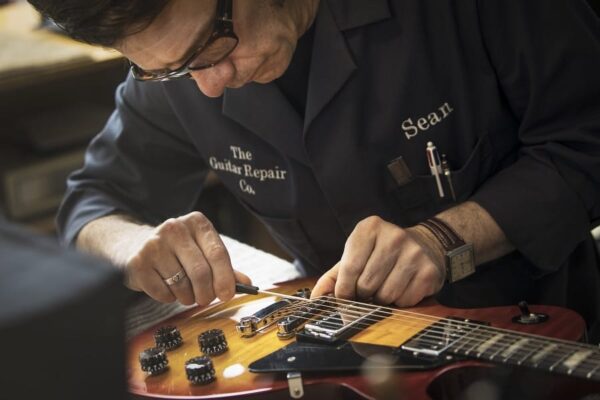
How to Fix a Guitar String (Electric & Acoustic Guitar)

What Do Guitar Calluses Look Like? (With Photos)
Begin typing your search term above and press enter to search. Press ESC to cancel.

- International edition
- Australia edition
- Europe edition

Tim Dowling: my banjo is out of tune, and the gig is falling apart
The band has every type of cock-up pretty much covered, but then things go from bad to worse
The band I’m in is playing over the weekend: Birmingham, Gateshead, Kendal. They are all venues we’ve played before, but not for a long while.
“Which is good,” says the guitar player as we drive north in the rain. “Because we can re-use all the jokes from last year.”
“Absolutely,” I say. The pockets of the waistcoat I wear on stage are loaded with scraps of paper containing scrawled lines to cover for all sorts of trouble: tuning problems, technical problems, and the wholly unforeseen. I should really swap them out for new jokes at some point, just as I should probably dry clean the waistcoat at some point. But not now – I have enough to worry about.
The gig in Birmingham goes surprisingly well; I am only obliged to dip into my waistcoat pocket once.
In Gateshead I rely on a proven anecdote about a fan called Angela, who in 2022 drove all the way from Aberdeen to see us play in Cambridge , just so she could buy one of our souvenir mugs, which are not available from the website. I know this because her friend approached me in the interval and asked if we could please dedicate a song to Angela.
“Otherwise,” she said, “It’s a long way to come for a fucking cup.”
This anecdote is so well worn I don’t need the bit of paper sitting in my right breast pocket. I’ve told it 50 times over the past two years.
“But tonight it has a special poignance,” I tell the people of Birmingham, “because I’m reliably informed that Angela is in the front row.” And so she is. Everyone cheers.
“Reliably informed,” says the piano player in the Travelodge afterward. “Like you had spies tracking her.”
“I was ad-libbing,” I say. “Anyway, I’ll probably have to retire that bit, because we’re out of mugs.”
On the third morning I wake up with a cold: my head is fogged; my throat is sore. Along with these symptoms I am possessed by an overwhelming sense of doom. Things have gone well so far. It is too much to hope that they will go well one more time.
And so it proves. Within minutes of getting on stage I find myself bewildered and at sea, struggling to remember songs I have played hundreds of times. I make it through the first half without any major errors, but I’m rattled by the cumulative effect of a dozen small ones.
Things go from bad to worse in the second half, after I misinterpret the set list at my feet, so that when the next song starts I find myself not just playing the wrong tune, but holding the wrong instrument.
I can see light at the end of the tunnel by the time my banjo goes badly out of tune in the middle of the penultimate number. Between songs I stop to retune and, when this begins to take longer than it should, I reach into the pocket of my waistcoat and pull out a perennially reliable scrap of paper.
I tell the audience an entirely confected story about creating a new banjo joke using AI. The first part of the story gets a big enough laugh that I decide to dispense with the second part – I’ve already taken up too much time. I put the bit of paper back in my pocket, and the final song begins.
I’m a big believer in never admitting your mistakes to an audience. Chances are they haven’t noticed, and there is nothing to be gained from coming clean. But this strategy has its limits, and I am about to test them.
The last song’s introduction is very spare, dominated by a haunting banjo figure that repeats itself after four bars. The first time it comes round, every single note is wrong. I hear the piano player snort with laughter behind me, but I’m already thinking about the second time round a few seconds hence: I know it’s going to go wrong again.
When it does, the song collapses. The band stops playing. It’s clear I have accidentally tuned my banjo to a different key entirely, and I cannot for the life of me see a way back. As I frantically re-tune in the heart-pounding silence that follows, the guitar player reaches into my waistcoat pocket, extracts the bit of paper and reads out the second part of my joke.
Everyone laughs.
“I came very close to running out the fire exit,” I say afterwards, as we pack up.
“I reckon the audience thought that whole bit was planned,” says the piano player.
“I guess it was lucky I’d left the second part of the joke for you,” I say to the guitar player.
“It was even luckier the whole thing was actually written out on that bit of paper,” he says.
“That’s not luck,” I say.
- Life and style
- The Tim Dowling column
Comments (…)
Most viewed.

IMAGES
VIDEO
COMMENTS
1. The Strings are Old. One of the biggest reasons why a guitar goes out of tune quickly, is because the strings are old. As strings get old and worn, they become less tense. You already know that the tension of the string is the ultimate factor which decides if the string is in tune or not. Old strings tend to sound sharper, because it's ...
Many guitarists develop a "sweetened" tuning for their guitar - over time they figure out that by detuning some of the strings very slightly, the imperfections are "evened out" so that the guitar sounds nicely in tune everywhere. James Taylor has popularized his own sweetened tuning, there's a YouTube video of him explaining the cent amounts ...
Choosing the Right Travel Guitar. The right guitar can make or break your traveling experience. When selecting a travel guitar, consider factors like size, durability, and portability. ... Changes in temperature and humidity can cause the wood to expand or contract, throwing your guitar out of tune. That's why having a tuner is essential ...
8 Reasons Why Your Guitar Goes Out of Tune Quickly. 1. Old Strings. Old worn out strings are the most common reason your guitar won't hold a tune for long. Most guitar strings are made of steel or have a steel core: and though it may not seem like it, steel is actually quite elastic. The more you play, the more your strings will stretch out ...
6. The Nut. Each string moves through a slot in the nut at the top of the fretboard, and if they're not moving through that slot smoothly, the result is tension on one side or the other. If the strings don't sit in those grooves along the nut's front edge as they move down the fretboard, you'll be out of tune throughout the neck.
Traveler Guitar getting out of tune so quickly. I have one and it's a challenge, but it can be better with some tweaking. In addition to the typical stuff on any guitar with this issue you need to make sure those "wheels" where the strings reverse under the guitar move as freely as possible. I put graphite between them.
I rarely have tuning issues with any of my other guitars, but the traveler was always going out of tune after a couple minutes. peskypesky Member. Messages 6,908. Dec 30, 2013 #3 I just bought a Xaviere JTT Travel guitar. They are on clearance sale for $109, ...
The giveaway for this is that your guitar will probably sound out of tune in many places on the neck, as well as having a dull bassy sound with no clarity. Action Issues. Action on a guitar refers to how high the strings are above the fretboard. Many cheaper guitars (and some more expensive ones too) have the action set too high from the factory.
Lessons. Why Your Guitar Sounds Out of Tune, Regardless of What Your Tuner Says. By Tyler Larson. published 1 September 2016. The easiest mistake to make as an eager, developing guitarist is to neglect the basics in our later stages of experience. Learning and mastering an instrument is all about peaks and valleys.
The short answer is that your guitar is out of tune, and always will be, and you just need to learn to deal with it. The long answer, my friends, is this: A monochord from the Musikinstrumenten-Museum in Berlin. Music, at it's most fundamental level, is math. Math doesn't just dictate rhythm, but it also dictates pitch: musical notes are ...
Cheap tuning pegs will cause a guitar to go out of tune constantly. The better the pegs, the less it will go out of tune. Share. Improve this answer. Follow answered Jan 13, 2011 at 21:37. yossarian yossarian. 3,499 5 5 gold badges 23 23 silver badges 29 29 bronze badges. Add a ...
In this lesson I go over the biggest reason why your guitar keeps guitar out of tune and how to help prevent that in the future. For more free guitar lesson...
Yamaha Guitalele GL1 is worth the mention as it sounds good and costs only 79 Euro. 5. dinesh moudgil 10 · Oct 29, 2017 11:36 AM · report · ↑ reply. The only drawback is the tuning, but i ...
The Role of Strings: The Foundation of Your Sound. One of the most common reasons why your guitar keeps going out of tune is the quality and condition of its strings. Strings are susceptible to wear and tear, and old or poor-quality strings are far more likely to lose their tuning quickly. If you notice your strings are tarnished, rusted, or if ...
You can use a tuner device or an app to do this. If the pitch at the 12th fret is higher than the open string (sharp), then you need to move the bridge saddle away from the neck (towards the tailpiece). If the pitch at the 12th fret is lower than the open string (flat), then you need to move the bridge saddle closer to the neck (towards the ...
High humidity levels can cause the wooden components of the guitar to expand, which could result in a flat tuning. Under ideal conditions, the humidity and temperature will cause the components of your guitar to contract, which means the tuning will go sharp. Keep a check on the climate and always keep your Guitar in the Guitar case to avoid ...
Tuning pegs. There are 2 main reasons why the tuning pegs contribute to tuning issues, and they're both equally as common. The first is because something has come loose. Usually, a screw which is allowing the tuner to rotate outside of the intended mechanical movement. Every time you change strings and clean your guitar, we recommend giving ...
Generally speaking, guitar strings go out of tune due to a variety of factors including improper winding of the strings, fluctuations in humidity and temperature, use of old or damaged strings, insufficient stretching of new strings, a poorly cut nut, or an improperly set up tremolo or bridge. Yes, there are many reasons why your guitar goes ...
4. Constant Whammy Bar Use. The nut of your guitar can be surprisingly temperamental if it isn't set up properly, and this is never truer when it comes to using your tremolo. Sustained use of the whammy bar will cause your strings to move around in the nut, and naturally become both slack and then tight in repetitive movements.
Intonation, in simple terms, is the guitar's ability to stay in tune across the entire fretboard. When intonation is off, you'll find that your guitar might sound in tune when playing open strings or lower frets, but increasingly out of tune as you go up the fretboard. Specifically, at the 12th fret, where each string should produce a pitch ...
6 Reasons why cheap guitars go out of tune. 1. Low-quality construction. The main reason why cheap guitars go out of tune more quickly is because of the low-quality construction and materials used. Sometimes, the neck might not be wholly aligned with the bridge or other mistakes. The quality control of guitars that are cheaply manufactured in ...
🔥In this classic 2020 episode of 𝙏𝙖𝙡𝙠𝙞𝙣𝙜 𝙎𝙝𝙧𝙚𝙙 we sat down with the Whammy Bar King ~ the Mighty Brad Gillis of Night Ranger ~ and discussed his...
As I frantically re-tune in the heart-pounding silence that follows, the guitar player reaches into my waistcoat pocket, extracts the bit of paper and reads out the second part of my joke.
This is a lesson for the old-time tune "Arkansas Traveler" in the key of D. We'll play this arrangement out of 'D position' and I've included two variations ...